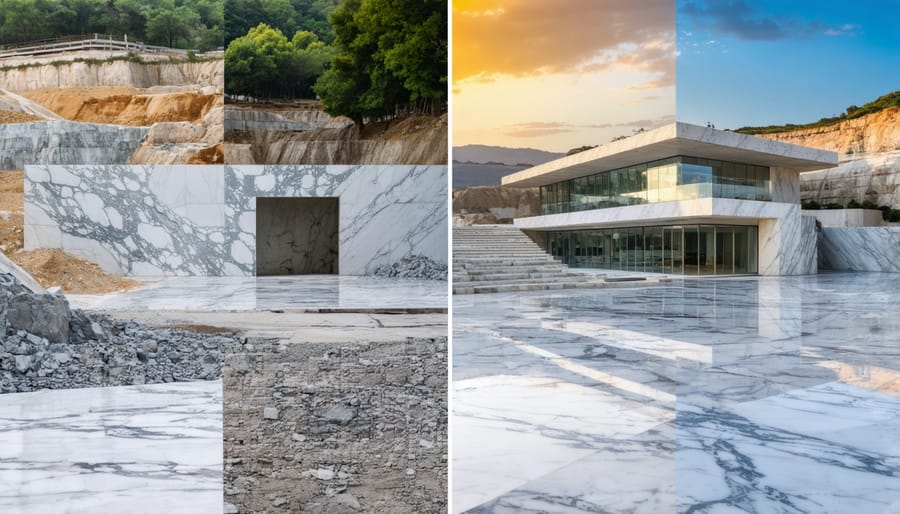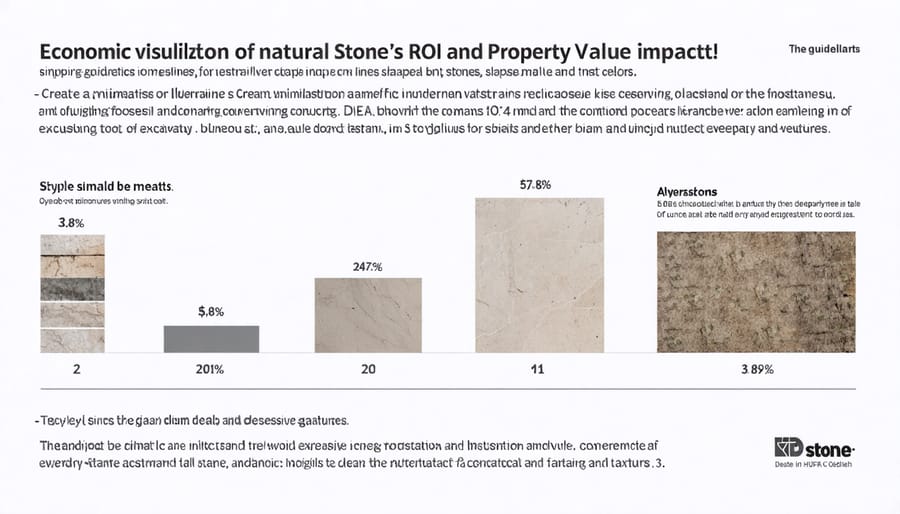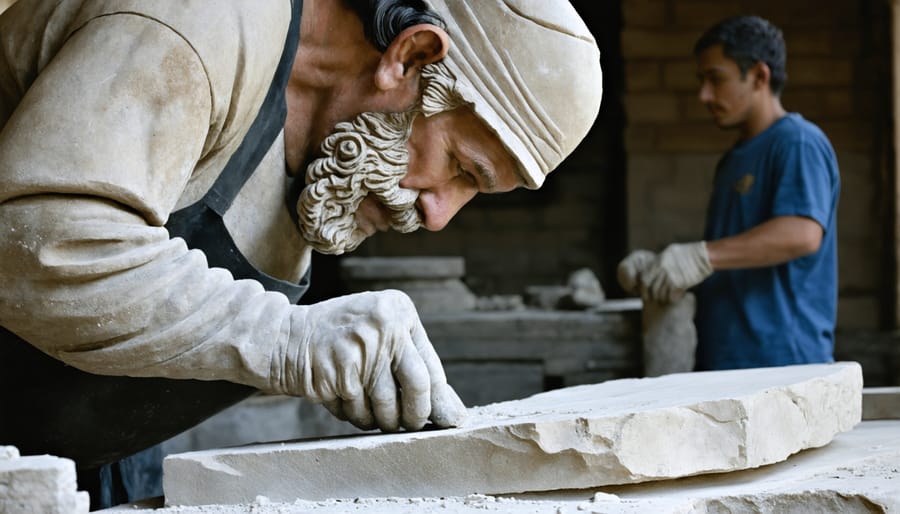Natural stone stands at the forefront of sustainable building materials, exemplifying the perfect balance between the three pillars of sustainability – environmental stewardship, economic viability, and social responsibility. As architects and designers increasingly prioritize the benefits of natural stone, its role in creating sustainable spaces has never been more relevant. From quarry to installation, stone demonstrates how building materials can simultaneously reduce environmental impact, boost local economies, and enhance community well-being. Whether it’s granite countertops that last generations, limestone facades that weather gracefully while reducing energy costs, or marble flooring that creates healthier indoor environments, natural stone exemplifies how traditional materials can meet modern sustainability demands. This exploration of sustainability’s three pillars through the lens of natural stone reveals practical solutions for today’s environmental challenges while ensuring economic growth and social progress.

Environmental Sustainability in Natural Stone
Durability and Longevity
Natural stone stands as a testament to enduring sustainability through its exceptional longevity. With a lifespan that can exceed several centuries, stone materials significantly reduce the environmental impact associated with frequent replacements and renovations. Unlike manufactured materials that might need replacement every 10-20 years, natural stone installations can maintain their integrity and aesthetic appeal for generations.
This durability translates directly into reduced resource consumption over time. When a stone countertop or facade remains functional for 100+ years, it eliminates the need for multiple replacement cycles, reducing the energy, materials, and carbon emissions associated with manufacturing and installing new products. Historic buildings across the globe showcase stone’s remarkable staying power, with many structures maintaining their original stone elements for hundreds of years with minimal maintenance.
The durability of natural stone also contributes to reduced waste in landfills. Even at the end of its primary use, stone can be repurposed, recycled, or returned to the earth without harmful environmental effects. This cradle-to-cradle potential makes it an exemplary choice for sustainable construction and design projects focused on long-term environmental stewardship.
Low Carbon Footprint
Natural stone stands out for its remarkably low environmental impact compared to alternative materials. The extraction process requires minimal energy consumption, as stone is simply quarried rather than manufactured. Modern quarrying techniques have evolved to maximize efficiency while minimizing waste, with many operations now utilizing solar power and water recycling systems.
Processing natural stone involves straightforward cutting and finishing steps that consume significantly less energy than the production of synthetic materials. Unlike manufactured products that require extensive chemical processing or high-temperature firing, stone processing primarily relies on mechanical methods. Additionally, stone quarries often implement rehabilitation programs, restoring sites to their natural state or repurposing them for community use.
The carbon footprint of natural stone is further reduced by its exceptional longevity and minimal maintenance requirements. Once installed, stone requires no chemical treatments or energy-intensive replacement cycles, making it a truly sustainable choice for long-term applications.
Recyclability and Waste Reduction
Natural stone stands out as a prime example of sustainable building materials due to its exceptional recyclability and minimal waste footprint. Unlike many manufactured materials, stone can be repurposed indefinitely without losing its inherent qualities. When buildings are demolished or renovated, stone elements can be reclaimed and reused in new construction projects, historic restorations, or landscaping applications.
The stone fabrication process itself generates minimal waste, as unused portions can be repurposed for smaller projects, crushed for aggregate, or processed into stone dust for soil enhancement. Modern cutting technologies have significantly improved material efficiency, allowing fabricators to optimize stone usage through precise cutting patterns and remnant management.
Additionally, stone’s durability means it rarely needs replacement, reducing the overall waste generated throughout a building’s lifecycle. This longevity, combined with its natural composition, ensures that even if stone materials eventually reach their end-use, they can safely return to the earth without causing environmental harm.
Economic Sustainability of Natural Stone
Long-term Cost Benefits
Natural stone’s long-term investment value extends far beyond its initial purchase price. While the upfront costs may be higher compared to synthetic materials, natural stone’s durability and longevity translate into significant cost savings over time. A well-maintained stone installation can last for generations, eliminating the need for frequent replacements that plague less durable materials.
The lifecycle cost analysis of natural stone reveals impressive returns on investment. Stone surfaces require minimal maintenance, typically needing only basic cleaning and occasional sealing, which reduces ongoing maintenance expenses. Unlike manufactured materials that may need replacement every 10-15 years, stone installations can maintain their beauty and functionality for 50 years or more.
Energy efficiency presents another cost benefit, as stone’s natural thermal mass properties help regulate indoor temperatures, potentially reducing heating and cooling costs by up to 25%. Additionally, stone’s timeless appeal and durability can increase property values, making it an attractive feature for future buyers and a wise investment for commercial and residential properties alike.

Local Economic Impact
Natural stone quarrying and processing significantly boost local economies through multiple channels. When stone is sourced locally, it creates sustainable jobs in quarrying, fabrication, and installation, providing stable employment opportunities for community members. These positions often offer competitive wages and require skilled labor, contributing to the development of a specialized workforce.
The economic impact extends beyond direct employment. Local stone operations generate tax revenue for municipalities, supporting public services and infrastructure development. They also stimulate auxiliary businesses, from transportation companies to equipment suppliers, creating a robust economic ecosystem.
Furthermore, using local stone reduces transportation costs and supports regional business growth. Many quarries and fabricators partner with local technical schools and apprenticeship programs, investing in workforce development and ensuring long-term industry sustainability. This economic activity helps maintain traditional craftsmanship while fostering innovation in stone processing techniques, creating a balanced approach to economic sustainability in the natural stone industry.
Market Value and Property Enhancement
Sustainable natural stone installations significantly boost property values and market appeal, offering lasting economic benefits for both residential and commercial projects. Properties featuring natural stone typically command 10-15% higher resale values compared to those with synthetic materials. This value appreciation stems from stone’s durability, timeless aesthetic, and growing consumer preference for sustainable building materials.
Market analysis shows that buildings incorporating sustainable stone elements attract environmentally conscious tenants and buyers, often resulting in faster property sales and higher rental rates. The initial investment in natural stone is offset by reduced maintenance costs, extended lifecycle, and enhanced market positioning. Properties showcasing locally sourced stone particularly benefit from increased market interest, as they demonstrate environmental responsibility while supporting regional economies.
Modern homebuyers and commercial clients increasingly prioritize sustainable building materials, making natural stone a strategic choice for long-term property value enhancement. This trend is expected to strengthen as sustainability continues to drive real estate market preferences.
Social Sustainability in the Stone Industry

Traditional Craftsmanship
Traditional stone masonry and craftsmanship represent vital elements of cultural heritage preservation, connecting modern sustainable practices with centuries-old skills. Master craftsmen continue to shape natural stone using time-honored techniques, creating durable structures and artistic elements that stand the test of time. These skilled artisans maintain knowledge passed down through generations, ensuring the survival of traditional building methods while adapting them to contemporary needs.
The preservation of stone craftsmanship supports local communities by providing specialized employment opportunities and maintaining regional architectural identities. In historic restoration projects, these skilled trades are essential for authentic preservation work, helping communities retain their cultural character while promoting sustainable building practices.
Stone workshops and training programs play a crucial role in perpetuating these traditional skills. By teaching younger generations the art of stone carving, installation, and restoration, the industry ensures the continuation of these valuable practices. This knowledge transfer not only preserves cultural heritage but also contributes to sustainable construction by promoting the use of natural, locally-sourced materials and repair-focused maintenance approaches that reduce waste and extend the lifespan of stone structures.
Community Development
Natural stone quarries and processing facilities often serve as economic anchors in local communities, providing stable employment opportunities across multiple generations. These operations create direct jobs in extraction, fabrication, and installation, while also supporting indirect employment through transportation, sales, and design services. Many quarrying companies invest in local workforce development programs, offering specialized training and apprenticeships that preserve traditional stoneworking skills while incorporating modern sustainable practices.
Beyond employment, stone projects frequently contribute to community revitalization efforts. Historic preservation work using local stone materials helps maintain cultural heritage while creating opportunities for skilled craftspeople. Quarry companies often partner with local educational institutions to provide learning opportunities and support community initiatives. Additionally, many abandoned quarries are transformed into public spaces, wildlife habitats, or recreational areas, demonstrating how the stone industry can contribute to long-term community development even after extraction ends.
Health and Safety Considerations
Natural stone stands out as an exemplary building material when it comes to health and safety considerations. Unlike many synthetic materials, stone doesn’t emit volatile organic compounds (VOCs) or other harmful chemicals, contributing to superior indoor air quality. This non-toxic nature makes it an ideal choice for spaces where occupant health is paramount, such as hospitals, schools, and residential environments.
The inherent properties of natural stone also make it resistant to mold, mildew, and bacterial growth, further supporting a healthy indoor environment. It doesn’t harbor allergens or provide breeding grounds for microorganisms, making it particularly beneficial for individuals with respiratory sensitivities or allergies.
Additionally, natural stone’s durability means it doesn’t degrade over time, ensuring its non-toxic properties remain consistent throughout its lifecycle. This stability eliminates concerns about chemical off-gassing or material breakdown that could potentially affect indoor air quality, making it a sustainable choice for long-term human health and safety.
Natural stone stands as a remarkable example of how building materials can embody all three pillars of sustainability. Its environmental credentials shine through its durability, low maintenance requirements, and minimal processing needs, significantly reducing its carbon footprint compared to manufactured alternatives. The material’s longevity and timeless appeal contribute to its economic sustainability, offering excellent return on investment through reduced lifecycle costs and increased property values.
From a social perspective, natural stone connects us to our architectural heritage while supporting contemporary communities through sustainable quarrying practices and skilled craftsmanship. The industry provides stable employment opportunities and preserves traditional stone-working techniques, ensuring these valuable skills pass to future generations.
By choosing natural stone, stakeholders invest in a material that harmoniously balances environmental stewardship, economic viability, and social responsibility. Its ability to meet present needs without compromising future generations’ resources makes it an exemplary model of holistic sustainability in construction and design. As we continue to prioritize sustainable building practices, natural stone remains a testament to how traditional materials can address modern sustainability challenges.










